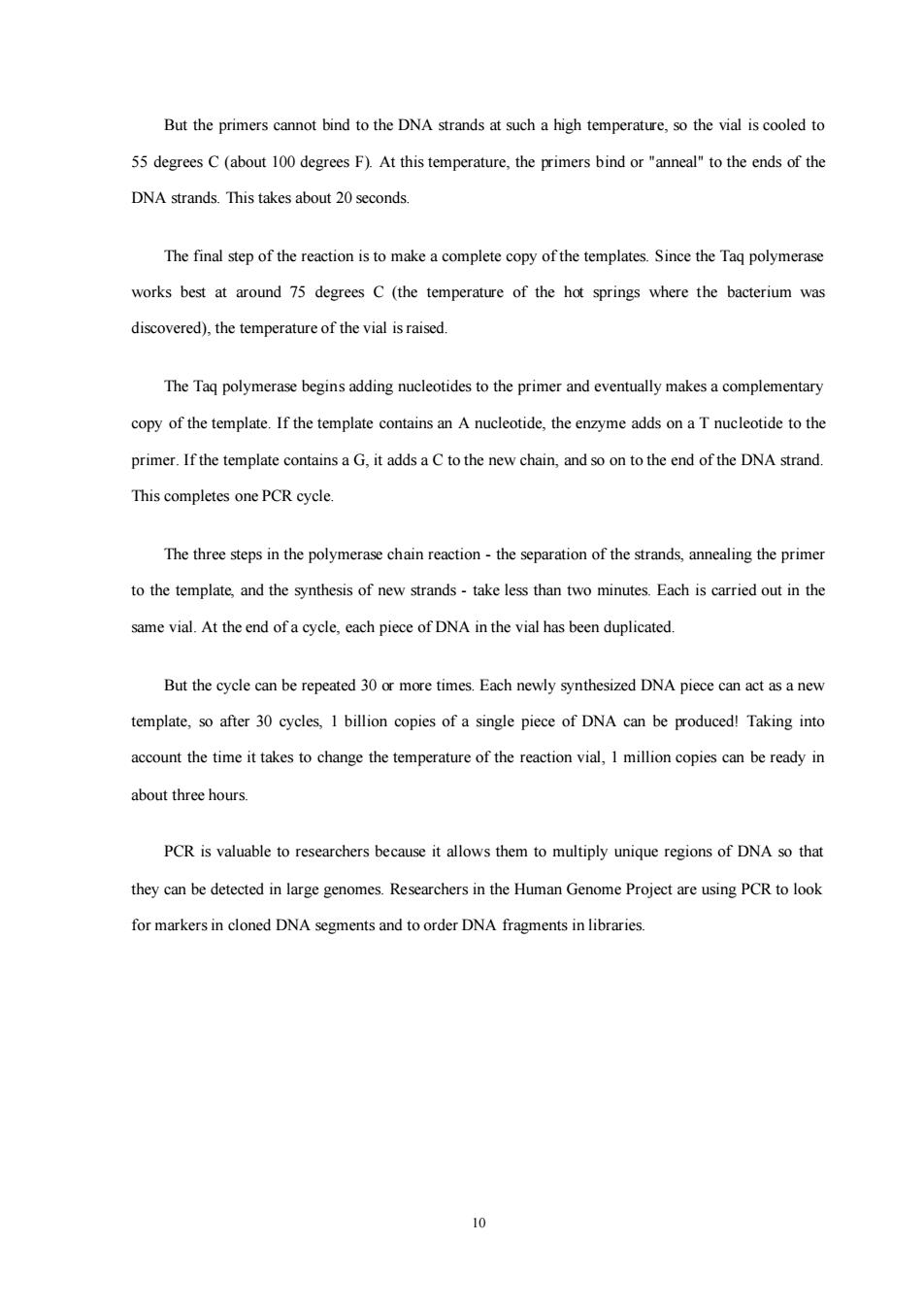
But the primers cannot bind to the DNA strands at such a high temperature,so the vial iscooldto 55 degrees C(about degrees F)At this temperature.the primers bind or"ato the ends of the DNA strands.This takes about 20seconds The final step of the reaction is to make a complete copy of the templates.Since the Taq polymerase works best at around 75 degrees C(the temperature of the hot springs where the bacterium was discovered),the temperature of the vial is raised. The Taq polymerase begins adding nucleotides to the primer and eventually makes a complementary copy of the template.If the template contains an A nucleotide,the enzyme adds onaTucleotide to the primer.Ifthe template containsaG.it new chain,and so on totheend of the DNA strand This completes one PCR cycle The three steps in the polymerase chain reaction-the separation of the strands,annealing the primer to the template,and the synthesis of new strands-take less than two minutes.Each is carried out in the same vial.At the end of a cycle,each piece of DNA in the vial has been duplicated. But the cycle can be repeated 30 more times.Each newly synthesized DNA piece can act as a new template.so after 30 cycles,I billion copies of a single piece of DNA can be produced!Taking into account the time it takes to change the temperature of the reaction vial,1 million copies can be ready in about three hours PCR is valuable to researchers because it allows them to multiply unique regions of DNA so that they can be detected in large genomes.Researchers in the Human Genome Project are using PCR to look for markers in cloned DNA segments and to order DNA fragments in libraries. 10
10 But the primers cannot bind to the DNA strands at such a high temperature, so the vial is cooled to 55 degrees C (about 100 degrees F). At this temperature, the primers bind or "anneal" to the ends of the DNA strands. This takes about 20 seconds. The final step of the reaction is to make a complete copy of the templates. Since the Taq polymerase works best at around 75 degrees C (the temperature of the hot springs where the bacterium was discovered), the temperature of the vial is raised. The Taq polymerase begins adding nucleotides to the primer and eventually makes a complementary copy of the template. If the template contains an A nucleotide, the enzyme adds on a T nucleotide to the primer. If the template contains a G, it adds a C to the new chain, and so on to the end of the DNA strand. This completes one PCR cycle. The three steps in the polymerase chain reaction - the separation of the strands, annealing the primer to the template, and the synthesis of new strands - take less than two minutes. Each is carried out in the same vial. At the end of a cycle, each piece of DNA in the vial has been duplicated. But the cycle can be repeated 30 or more times. Each newly synthesized DNA piece can act as a new template, so after 30 cycles, 1 billion copies of a single piece of DNA can be produced! Taking into account the time it takes to change the temperature of the reaction vial, 1 million copies can be ready in about three hours. PCR is valuable to researchers because it allows them to multiply unique regions of DNA so that they can be detected in large genomes. Researchers in the Human Genome Project are using PCR to look for markers in cloned DNA segments and to order DNA fragments in libraries
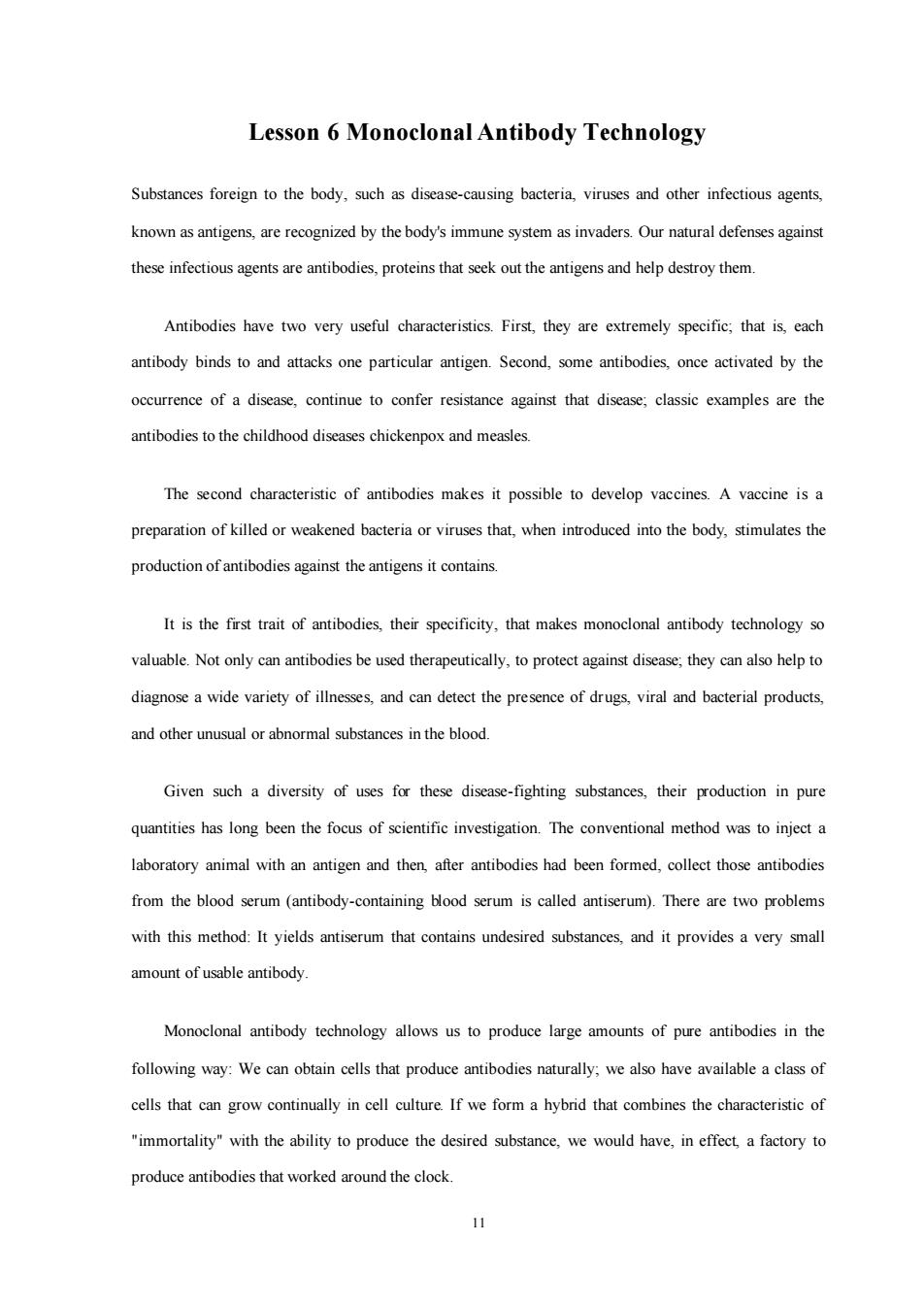
Lesson 6 Monoclonal Antibody Technology Substances foreign to the body,such as disease-causing bacteria,viruses and other infectious agents known as antigens,are recognized by the body's immune system as invaders.Our natural defenses against these infectious agents are antibodies,proteins that seek out the antigens and help destroy them. Antibodies have two very useful characteristics.First,they are extremely specific:that is,each antibody binds to and attacks one particular antigen.Second,some antibodies,once activated by the occurrence of a disease,continue to confer resistance against that disease:classic examples are the antibodies to the childhood diseases chickenpox and measles The second characteristic of antibodies makes it possible to develop vaccines.A vaccine is a preparation of killed or weakened bacteriaor viruses that,when introduced into the body,stimulates the production of antibodies against the antigens it contains. It is the first trait of antibodies,their specificity.that makes monoclonal antibody technology so valuable.Not only can antibodies be used therapeutically,to protect against disease they can also help to diagnoa wide variety of iless and can detect the presence of drugs,viral and bacterial products, and other unusual or abnormal substances in the blood. Given such a diversity of uses for these disease-fighting substances,their production in pure quantities has long been the focus of scientific investigation.The conventional method was to inject a laboratory animal with an antigen and then,after antibodies had been formed,collect those antibodies from the blood rum(antibody-containing bood serum is called antiserum).There are two problems with this method:It yields that contains undesired substances,and it provides a very small amount of usable antibody. Monoclonal antibody technology allows us to produce large amounts of pure antibodies in the following way:We can obtain cells that produce antibodies naturally:we also have available a class of cells that can grow continally in cell culture If we form a hybrid that combines the characteristic of "immortalitywith the ability to produce the desired substance,we would have,in effect,a factory to produce antibodies that worked around the clock. 11
11 Lesson 6 Monoclonal Antibody Technology Substances foreign to the body, such as disease-causing bacteria, viruses and other infectious agents, known as antigens, are recognized by the body's immune system as invaders. Our natural defenses against these infectious agents are antibodies, proteins that seek out the antigens and help destroy them. Antibodies have two very useful characteristics. First, they are extremely specific; that is, each antibody binds to and attacks one particular antigen. Second, some antibodies, once activated by the occurrence of a disease, continue to confer resistance against that disease; classic examples are the antibodies to the childhood diseases chickenpox and measles. The second characteristic of antibodies makes it possible to develop vaccines. A vaccine is a preparation of killed or weakened bacteria or viruses that, when introduced into the body, stimulates the production of antibodies against the antigens it contains. It is the first trait of antibodies, their specificity, that makes monoclonal antibody technology so valuable. Not only can antibodies be used therapeutically, to protect against disease; they can also help to diagnose a wide variety of illnesses, and can detect the presence of drugs, viral and bacterial products, and other unusual or abnormal substances in the blood. Given such a diversity of uses for these disease-fighting substances, their production in pure quantities has long been the focus of scientific investigation. The conventional method was to inject a laboratory animal with an antigen and then, after antibodies had been formed, collect those antibodies from the blood serum (antibody-containing blood serum is called antiserum). There are two problems with this method: It yields antiserum that contains undesired substances, and it provides a very small amount of usable antibody. Monoclonal antibody technology allows us to produce large amounts of pure antibodies in the following way: We can obtain cells that produce antibodies naturally; we also have available a class of cells that can grow continually in cell culture. If we form a hybrid that combines the characteristic of "immortality" with the ability to produce the desired substance, we would have, in effect, a factory to produce antibodies that worked around the clock
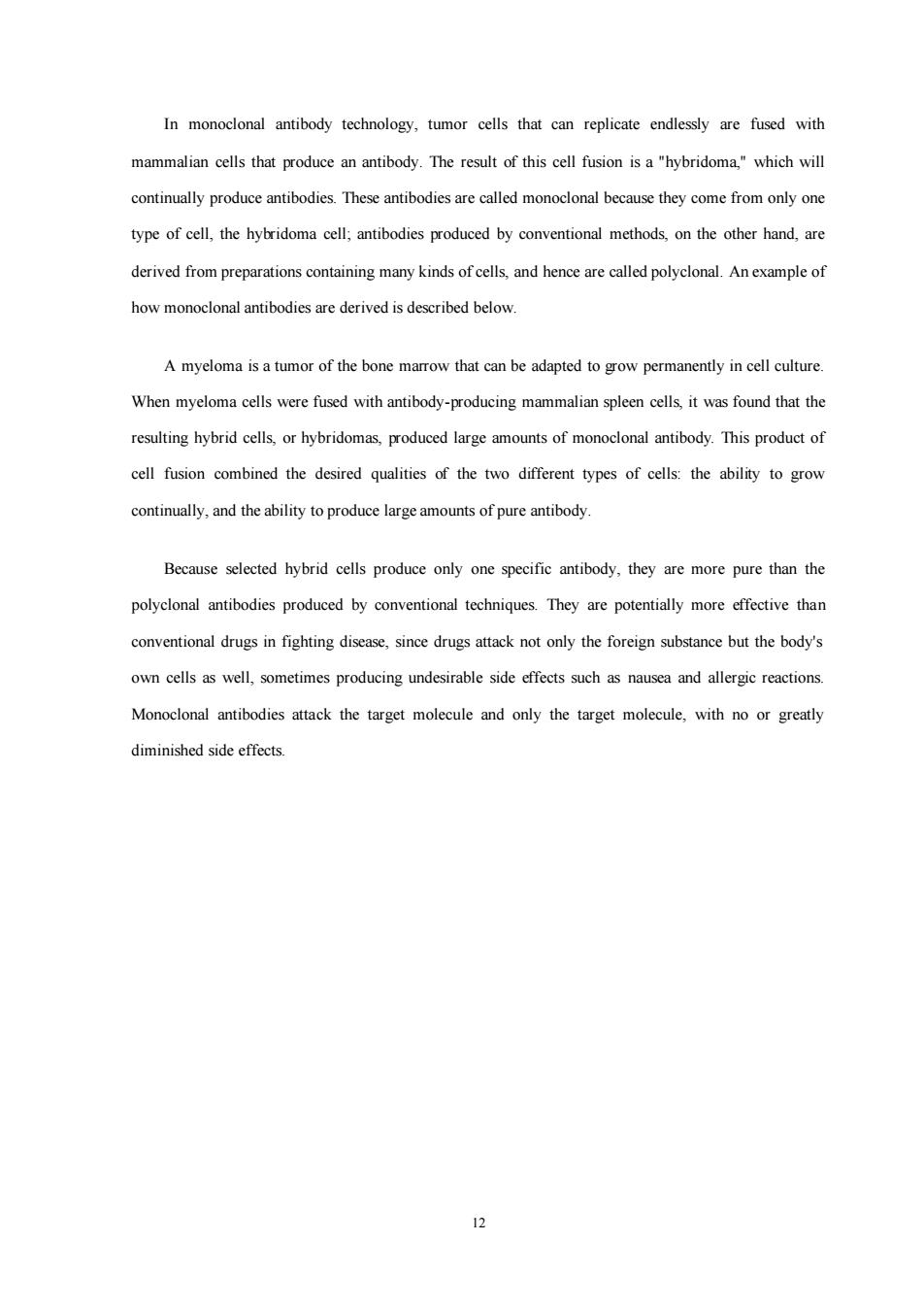
In monoclonal antibody technology,tumor cells that can replicate endlessly are fused with mammalian cells that produce an antibody.The result of this cell fusion is a"hybridoma,"which will continually produce antibodies.These antibodies are called monoclona because they come from onlyone type of cell,the hybridoma cell:antibodies produced by conventional methods,on the other hand,are derived from preparations containing many kinds of cells,and hence are called polyclonal.Anexample of how monoclon antibodies are derived is described below A myeloma is a tumor of the bone marrow that can be adapted to grow permanently in cell culture. When myeloma cells were fused with antibody-producing mammalian spleen cellsit was found that the large amouns of antibody.This product of cell fusion combined the desired qualities of the two different types of cells:the ability to grow continually,and the ability to produce large amounts of pure antibody. Because selected hybrid cells produce onyone specific antibody,they are more pure than the polyclonal antibodies produced by conventional techniques.Theyare potentially more effective tha conventional drugs in fighting disease,since drugs attack not only the foreign substance but the body's own cells as well,sometimes producing undesirable side effects such as nausea and allergic reactions Monoclonal antibodies attack the target molecule and only the target molecule,with no or greatly diminished side effects 2
12 In monoclonal antibody technology, tumor cells that can replicate endlessly are fused with mammalian cells that produce an antibody. The result of this cell fusion is a "hybridoma," which will continually produce antibodies. These antibodies are called monoclonal because they come from only one type of cell, the hybridoma cell; antibodies produced by conventional methods, on the other hand, are derived from preparations containing many kinds of cells, and hence are called polyclonal. An example of how monoclonal antibodies are derived is described below. A myeloma is a tumor of the bone marrow that can be adapted to grow permanently in cell culture. When myeloma cells were fused with antibody-producing mammalian spleen cells, it was found that the resulting hybrid cells, or hybridomas, produced large amounts of monoclonal antibody. This product of cell fusion combined the desired qualities of the two different types of cells: the ability to grow continually, and the ability to produce large amounts of pure antibody. Because selected hybrid cells produce only one specific antibody, they are more pure than the polyclonal antibodies produced by conventional techniques. They are potentially more effective than conventional drugs in fighting disease, since drugs attack not only the foreign substance but the body's own cells as well, sometimes producing undesirable side effects such as nausea and allergic reactions. Monoclonal antibodies attack the target molecule and only the target molecule, with no or greatly diminished side effects
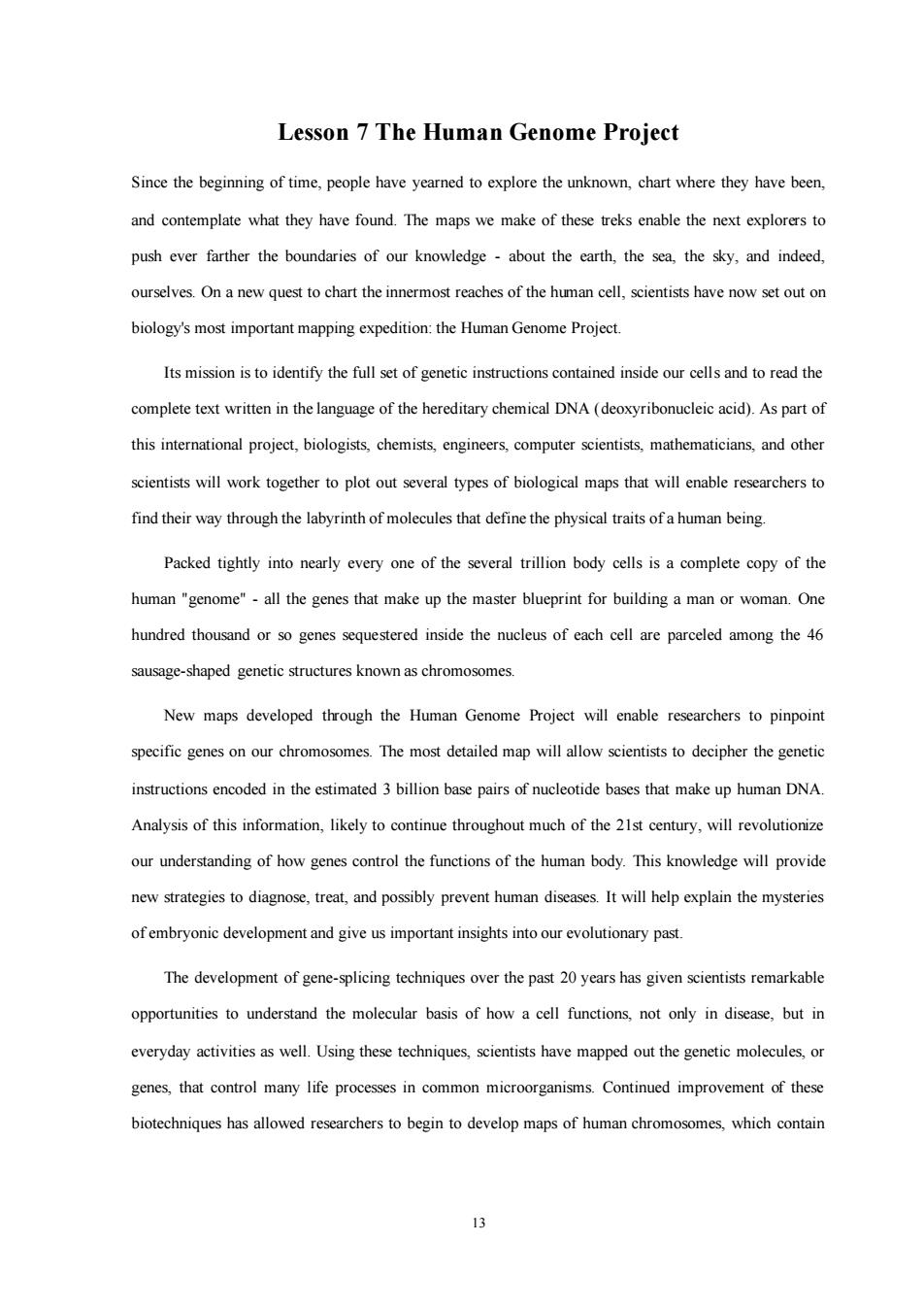
Lesson 7 The Human Genome Project Since the beginning of time,people have yearned to explore the unknown,chart where they have been and contemplate what they have found.The maps we make of these treks enable the next explorers to push ever farther the boundaries of our knowledgeabout the earth,the sea the y and indeed, ourselves On a new quest to chart the innermost reaches of the human cell.scientists have now setouton biologys most important mapping expedition:the Human Genome Project Its mission is to identify the full s of genetic instructions contained inside our cells and to read the complete text written in the language of the hereditary chemical DNA (deoxyribonuclic acid).As part of this international project biologists.chemistsengneers computer sentistsmathematicians.and other scientists will work together to plot types of maps that will findtheir way through the labyrinth of mocu that define the physical traits ofa human being Packed tightly into nearly every one of the several trillion body cells is a complete copy of the human"genome"-all the genes that make up the master blueprint for building a man or woman.One hundred thousand or so genes squestred inside the nucleus of each cell are parceled among the 46 sausage-shaped genetic structures known as chromosomes New maps developed through the Human Genome Project will enable researchers to pinpoint specific genes on our chromosomes.The most detailed map will allow scientists to decipher the genetic instructions encoded in the estimated 3 billion base pairs of nucleotide bases that make up human DNA Analysis of this information,likely of,wil ourunderstanding of how genes con the functions of the human body.This knowledge will provide new strategies to diagnose,treat,and possibly prevent human diseases.It will help explain the mysteries of embryonic development and give us important insights intoour volutionary past. The development of gene-splicing techniquesover the past 20years has given scientists remarkable opportunities to understand the molecuar basis of how a cel functions,not only in disse,but in everyday activities as well.Using these techniques.scientists have mapped out the genetic moleculesor genes,that contro many life processes in common microorganisms.Continued improvement of these biotechniques has allowed researchers to begin to develop maps of human chromosomes,which contain
13 Lesson 7 The Human Genome Project Since the beginning of time, people have yearned to explore the unknown, chart where they have been, and contemplate what they have found. The maps we make of these treks enable the next explorers to push ever farther the boundaries of our knowledge - about the earth, the sea, the sky, and indeed, ourselves. On a new quest to chart the innermost reaches of the human cell, scientists have now set out on biology's most important mapping expedition: the Human Genome Project. Its mission is to identify the full set of genetic instructions contained inside our cells and to read the complete text written in the language of the hereditary chemical DNA (deoxyribonucleic acid). As part of this international project, biologists, chemists, engineers, computer scientists, mathematicians, and other scientists will work together to plot out several types of biological maps that will enable researchers to find their way through the labyrinth of molecules that define the physical traits of a human being. Packed tightly into nearly every one of the several trillion body cells is a complete copy of the human "genome" - all the genes that make up the master blueprint for building a man or woman. One hundred thousand or so genes sequestered inside the nucleus of each cell are parceled among the 46 sausage-shaped genetic structures known as chromosomes. New maps developed through the Human Genome Project will enable researchers to pinpoint specific genes on our chromosomes. The most detailed map will allow scientists to decipher the genetic instructions encoded in the estimated 3 billion base pairs of nucleotide bases that make up human DNA. Analysis of this information, likely to continue throughout much of the 21st century, will revolutionize our understanding of how genes control the functions of the human body. This knowledge will provide new strategies to diagnose, treat, and possibly prevent human diseases. It will help explain the mysteries of embryonic development and give us important insights into our evolutionary past. The development of gene-splicing techniques over the past 20 years has given scientists remarkable opportunities to understand the molecular basis of how a cell functions, not only in disease, but in everyday activities as well. Using these techniques, scientists have mapped out the genetic molecules, or genes, that control many life processes in common microorganisms. Continued improvement of these biotechniques has allowed researchers to begin to develop maps of human chromosomes, which contain
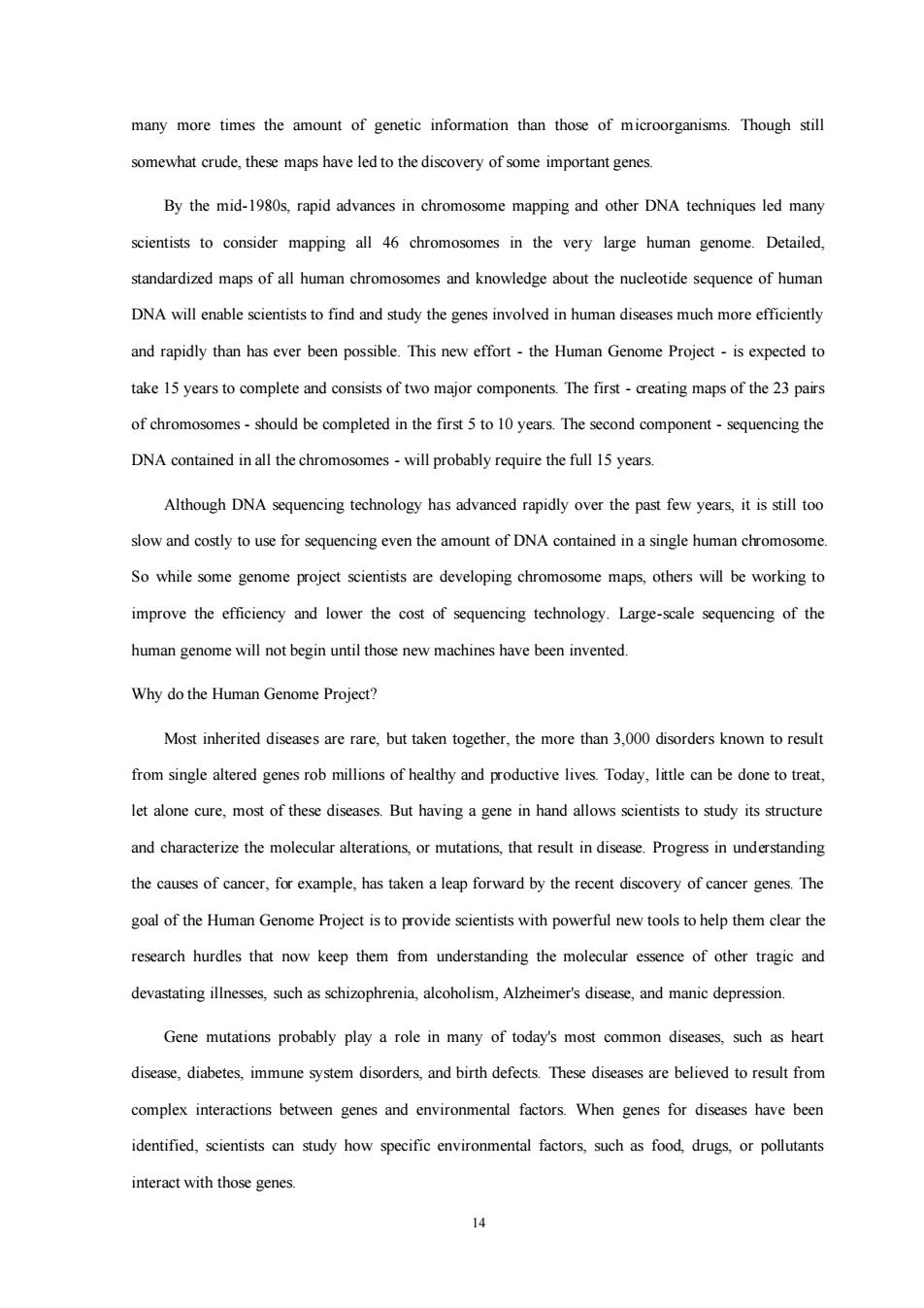
many more times the amount of genetic information than those of microorganisms.Though still somewhat crude,these maps have led to the discovery of some important genes By the mid-1980s,rapid advances in chromosome mapping and other DNA techniques led many scientists to consider mapping all 46 chromosomes in the very large human genome.Detailed, standardized maps of all human chromosomes and knowledge about the nucleotide sequence of human DNA will enable scientists to find and study the genes involved in human diseases much more efficiently and rapidly than has ever been possible.This new effort-the Human Genome Projectis expected to take 15 years to complete and consists of two major components.The first-creating maps of the 23 pairs of chromosomes-should be completed in the first 5 to 10 years.The second component-sequencing the DNA inall the probably require the full 15 years Although DNA technology has advanced rapidly over the past few years,it issill too slow and costy to use for sequencing even the amount of DNA contained in a single human. So while some genome project scientists are developing chromosome maps,others will be working to improve the efficiency and lower the cost of sequencing technology.Large-scale sequencing of the human genome will not begin until those new machines have been invented. Why do the Human Genome Project? Most inherited diseases are rare.but taken together,the more than 3,000 disorders known to resul from single atered genes rob millions of healthy and productive lives Today,tecan be done to treat. let alone cure,most of these diseases.But having a gene in hand allows scientists to study its structure and characterize the molecular alterationsor mutations,that result indisease.Progress in understanding the causes of cancer,for example,has taken a leap forward by the recent discovery of cancer genes.The goal of the Human Genome Project is to provide scientists with powerful new tools to help them clear the research hurdles that now keep them from understanding the molecular essence of other tragic and such as schizophrenia,alcoholism,Alzheimer's disease.and manic depression Gene mutations probably play a role in many of today's most common diseases,such as heart disease,diabetes immune system disorders,and birth defects These diseases are believed to result from complex interactions between genes and environmental factors.When genes for diseases have been identified,scientists can study how specific environmental factors,such as food,drugs,or pollutants interact with those genes 14
14 many more times the amount of genetic information than those of microorganisms. Though still somewhat crude, these maps have led to the discovery of some important genes. By the mid-1980s, rapid advances in chromosome mapping and other DNA techniques led many scientists to consider mapping all 46 chromosomes in the very large human genome. Detailed, standardized maps of all human chromosomes and knowledge about the nucleotide sequence of human DNA will enable scientists to find and study the genes involved in human diseases much more efficiently and rapidly than has ever been possible. This new effort - the Human Genome Project - is expected to take 15 years to complete and consists of two major components. The first - creating maps of the 23 pairs of chromosomes - should be completed in the first 5 to 10 years. The second component - sequencing the DNA contained in all the chromosomes - will probably require the full 15 years. Although DNA sequencing technology has advanced rapidly over the past few years, it is still too slow and costly to use for sequencing even the amount of DNA contained in a single human chromosome. So while some genome project scientists are developing chromosome maps, others will be working to improve the efficiency and lower the cost of sequencing technology. Large-scale sequencing of the human genome will not begin until those new machines have been invented. Why do the Human Genome Project? Most inherited diseases are rare, but taken together, the more than 3,000 disorders known to result from single altered genes rob millions of healthy and productive lives. Today, little can be done to treat, let alone cure, most of these diseases. But having a gene in hand allows scientists to study its structure and characterize the molecular alterations, or mutations, that result in disease. Progress in understanding the causes of cancer, for example, has taken a leap forward by the recent discovery of cancer genes. The goal of the Human Genome Project is to provide scientists with powerful new tools to help them clear the research hurdles that now keep them from understanding the molecular essence of other tragic and devastating illnesses, such as schizophrenia, alcoholism, Alzheimer's disease, and manic depression. Gene mutations probably play a role in many of today's most common diseases, such as heart disease, diabetes, immune system disorders, and birth defects. These diseases are believed to result from complex interactions between genes and environmental factors. When genes for diseases have been identified, scientists can study how specific environmental factors, such as food, drugs, or pollutants interact with those genes